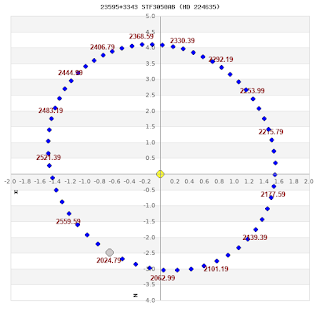This past week I've had my new-to-me GSO 10" f/12 Classical Cassegrain set-up in my backyard. Besides trying out the scope, it's also the first time to set-up the Losmandy G11 -- altogether a fairly steep learning curve.
I plan to use this set-up in the generally good seeing at Fremont Peak to observe planets and double stars unavailable to me from home, those either too far south or to the north. Reviews indicate the optical quality is good, and I should be able to reach the 0.5" Dawes limit. I set-up the scope with my 80mm f/7 ED as the finder scope -- I wanted to have the occasion to use this scope for both wide field and to resolve brighter binaries. The payload is 43 pounds, still within the weight limit of the mount -- though I found some shakiness and find I need to really tighten everything down. I might switch from my portable pier to a tripod. The stock focuser on the 10-inch is horrible -- very mushy -- and I've bought an adapter so I can use a Feathertouch I have instead (which should allow me to reach focus with binoviewers too). I collimated the scope fairly well, but I need more practice with it. I've struggled learning how to use the Gemini 2 on the mount, the instructions are not clear. I have been able to align it and figure out how to start modeling it, but here too I need more practice. The motors seem unusually loud, and might be annoying (since I'd be slewing every few minutes, unlike an astrophotographer who just tracks for hours at a time...). I made a few observations with it so far, as below.
I have thought that a good refractor would be a better choice -- cleaner views when in average seeing -- but I'll stick with this set-up and see what results can be had when it's performing at its best. I suppose I would only be going up the Peak when seeing would be forecasted to be excellent in any case, so the aperture problem should not be a dealstopper.
Also in other news, I finally took the Dalton objective up to Chabot to have R3 tested. It is not spherical, rather an oblate spheroid.
My thoughts are: If Dalton could not get the easiest of the Rx figures correct, there is high probability the other surfaces need even more work. Given there is no local resource willing to help, and that I don't have the patience to try to refigure this myself, I plan to sell or give away the Dalton and will buy a ready-made objective--with a push-pull cell--instead. I picked up a 9-foot aluminum tube yesterday which someone kindly offered to me -- it had been in their house for 50 years waiting for a refractor project which never materialized. Since it's a shorter tube, I can build a scope around it with an f/12 objective, and even re-use the Dalton tailpiece (the tube is the same diameter as the Dalton). If someone takes the Dalton objective, they can have the tube. Once I find and buy a new objective I'll offer-up the Dalton.
STF 182 AB: 250; 170x: Slightly unequal, well split. -12% PRO, it is not binary.
01h 56m 23.56s +61° 16' 52.0" P.A. 124.00 sep 3.6 mag 8.31,8.35 Sp B7V dist. 1754.39 pc (5722.82 l.y.)
STF 443 AB: 250; 170x: Light orange wide stars, 1 Dm. -79% PRO, it is not binary, in spite of grade 4 SOC orbit.
03h 47m 02.11s +41° 25' 38.1" P.A. 57.00 sep 6.8 mag 8.20,8.82 Sp K2V+K3V dist. 21.91 pc (71.47 l.y.)
STF 446 AB: 250; 170x: 2 Dm, wide. 41% PRO, 9,536 AU WS, 6.8+3.5 Msol, it is possibly binary and needs an orbit.
03h 49m 27.57s +52° 39' 19.4" P.A. 254.00 sep 8.8 mag 6.86,9.90 Sp B0.5III dist. 1098.9 pc (3584.61 l.y.)
STF 448 AB: 250; 170x: Very bright white A, well separated 3 Dm B. -32% PRO, it is not binary.
03h 47m 52.66s +33° 35' 59.5" P.A. 13.00 sep 3.5 mag 6.68,9.36 Sp B2.5V dist. 325.73 pc (1062.53 l.y.)
STF 464 AB: 250; 170x: Bright white A, B was easy, well split. 56% PRO, 3,450 AU WS, 8.1+1.9, it is possibly binary and needs an orbit. Slightly dimmer C and D further out. C shares similar parallax but does not overlap. D is a widely varying parallax.
03h 54m 07.92s +31° 53' 01.2" P.A. 208.00 sep 12.8 mag 2.86,9.16 Sp B1Ib dist. 230.41 pc (751.6 l.y.)
STT 59 AB: 250; 170x: First observation made with the 10-inch CC. Light orange stars, 1 Dm, well split. 52% PRO, 369 AU WS, 1.9+1.6 Msol, it is likely binary and needs an orbit.
03h 40m 40.62s +46° 01' 24.1" P.A. 355.00 sep 2.8 mag 7.90,8.85 Sp G5 dist. 111.36 pc (363.26 l.y.)
STT 66 AB: 250; 330x: Near equal white stars, good split. 92% PRO, 238 AU WS, 2.3+2.1 Msol, it is certainly binary. SOC grade 4 orbit, 1198-year period.
03h 52m 04.69s +40° 47' 50.7" P.A. 146.00 sep 1.0 mag 8.11,8.54 Sp A2 dist. 236.41 pc (771.17 l.y.)











